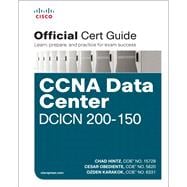Cisco Data Center DCICN 200-150 Official Cert Guide from Cisco Press allows you to succeed on the exam the first time and is the only self-study resource approved by Cisco. Cisco Data Center experts Chad Hintz, Cesar Obediente, and Ozden Karakok share preparation hints and test-taking tips, helping you identify areas of weakness and improve both your conceptual knowledge and hands-on skills.
This complete study package includes
- A test-preparation routine proven to help you pass the exam
- Do I Know This Already? quizzes, which allows you to decide how much time you need to spend on each section
- Chapter-ending exercises, which help you drill on key concepts you must know thoroughly
- The powerful Pearson IT Certification Practice Test software complete with hundreds of well-reviewed, exam-realistic questions customization options, and detailed performance reports
- A final preparation chapter, which guides you through tools and resources to help you craft your review and test-taking strategies
- Study plan suggestions and templates to help you organize and optimize your study time
Well-regarded for its level of detail, study plans, assessment features, challenging review questions and exercises, this official study guide helps you master the concepts and techniques that ensure your exam success.
The official study guide helps you master topics on the CCNA 200-150 exam, including the following:
- Nexus data center infrastructure and architecture
- Networking models, Ethernet LANs, and IPv4/IPv6 addressing/routing
- Data center Nexus switching and routing fundamentals
- Nexus switch installation and operation
- VLANs, trunking, STP, and Ethernet switching
- IPv4 and IPv6 subnetting
- IPv4 routing concepts, protocols, configuration, and access control
- Data center storage networking technologies and configurations








